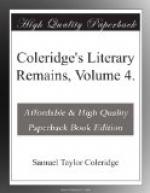Ib. p. 434.
Witness, again, the poet Milton, who introduces
active sports among
the recreations which he deemed worthy
of angels, and (strange indeed
for a Puritan!) included even dancing
among the number.
How could a man of Noble’s sense and sensibility bring himself thus to profane the awful name of Milton, by associating it with the epithet “Puritan?”
I have often thought of writing a work to be entitled ’Vindiciae Heterodoxae, sive celebrium virorum [Greek: paradogmatizonton] defensio’; that is, Vindication of Great Men unjustly branded; and at such times the names prominent to my mind’s eye have been Giordano Bruno, Jacob Behmen, Benedict Spinoza, and Emanuel Swedenborg. Grant, that the origin of the Swedenborgian theology is a problem; yet on which ever of the three possible hypotheses—(possible I mean for gentlemen, scholars and Christians)—it may be solved—–namely:
1. Swedenborg’s own assertion and constant belief in the hypothesis of a supernatural illumination; or,
2. that the great and excellent man was led into this belief by becoming the subject of a very rare, but not (it is said) altogether unique, conjunction of the somniative faculty (by which the products of the understanding, that is to say, words, conceptions and the like, are rendered instantaneously into forms of sense) with the voluntary and other powers of the waking state; or,
3. the modest suggestion that the first and second may not be so incompatible as they appear—still it ought never to be forgotten that the merit and value of Swedenborg’s system do only in a very secondary degree depend on any one of the three. For even though the first were adopted, the conviction and conversion of such a believer must, according to a fundamental principle of the New Church, have been wrought by an insight into the intrinsic truth and goodness of the doctrines, severally and collectively, and their entire consonance with the light of the written and of the eternal word, that is, with the Scriptures and with the sciential and the practical reason. Or say that the second hypothesis were preferred, and that by some hitherto unexplained affections of Swedenborg’s brain and nervous system, he from the year 1743, thought and reasoned through the ‘medium’ and instrumentality of a series of appropriate and symbolic visual and auditual images, spontaneously rising before him, and these so clear and so distinct, as at length to overpower perhaps his first suspicions of their subjective nature, and to become objective for him, that is, in his own belief of their kind and origin,—still the thoughts, the reasonings, the grounds, the deductions, the facts illustrative, or in proof, and the conclusions, remain the same; and the reader might derive the same benefit from them as from the sublime and impressive truths conveyed in the Vision of Mirza or the Tablet of Cebes. So much even from a very partial acquaintance with the works of Swedenborg, I can venture to assert; that as a moralist Swedenborg is above all praise; and that as a naturalist, psychologist, and theologian, he has strong and varied claims on the gratitude and admiration of the professional and philosophical student.—April 1827.




